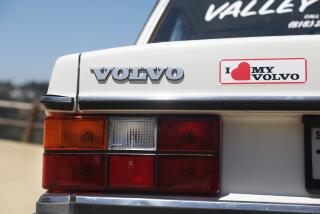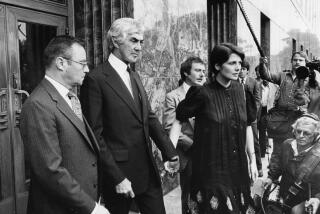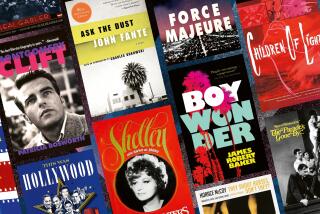Star Vehicles : The right movie role can polish an image and pump up earning power. The wrong one can backfire. Not just for actors--we’re talking about cars here.
Car makers, like film actors, may rise and falter by their choice of roles.
In 1963, Bentley Motors decided not to supply a car for a British movie. Bad move. Another vehicle was cast as Sean Connery’s co-star in “Goldfinger” and Aston Martin’s DB5 became a symbol of the genre alongside 007, shaken martinis and Miss Moneypenny.
Last year, Rolls-Royce said thanks, but no thanks when asked to provide a regal blacklimousine for the Buckingham Palace scene in “Patriot Games.” Good call. Now an Austin Princess will be remembered as the vehicle that sprung its doors and left occupants defenseless against terrorists’ bullets.
Both cases were in-house decisions by car makers.
But these days--as competition for free advertising is elevated to a human science, as directors decree a car as crucial to the character as a costume--movie appearances by automobiles are the specialist crusade of placement agencies in pursuit of The Golden Moment: exposure in blockbuster movies such as “The Firm” or “Jurassic Park” that may present a client’s vehicle to millions of Americans.
“The work used to be more off-the-cuff, the result of a chat with someone who says: ‘Hey, I can get you in,’ ” recalls Eric Dahlquist, president of Vista Group of Van Nuys, a pioneer purveyor of Mercedes, GMC trucks and several flavors of GM cars.
“Now it is controlled in a more business-like manner by a half-dozen agencies with a greater feel for the ebb and flow of Hollywood . . . with standards, insurance and maintenance requirements, and (operating) more like a car company than a movie company.”
Studios, Dahlquist says, do not pay for vehicles.
Although a business of influence, he adds, bribing directors or transportation coordinators remains a rumor that rarely rises above a nasty whisper, and is firmly denied by studios and placement agencies.
Standards are strict. Cars borrowed for filming must stay within camera range and cannot not be used by directors for weekends at Ojai Ranch. They will be brought back in the same condition they went out. Or the studio pays.
Makers of up-market imports insist their loaners will not be driven by bad guys. They cannot be shown as steaming wrecks. Nor on the wrong end of police chases or involved in on-screen crimes.
“If an actor is the drug dealer, the pimp, or the hit man, he’s not going to be seen driving a Rolls-Royce,” says Reg Abbiss, a company spokesman. “We ask for scripts in advance and approve only if the car is going to be driven by a person we’d all like to be, in a nice setting, in its own firmament as it were. But not in some back alley with bloodletting going on.”
Or in any condition in which--as Rolls-Royce is wont to say--the vehicle is unable to proceed.
If a movie shows a Mercedes leapfrogging police cruisers or used as a PLO gun platform, dollars to bratwurst the car was not obtained from Vista or Mercedes.
But sometimes you flip a coin.
The script for “The Rookie” called for Clint Eastwood and Charlie Sheen--or at least their stunt doubles--to drive a Mercedes 500SL through a warehouse window and onto the roof of an adjoining building. The warehouse was wired to explode behind the mid-air Mercedes.
Vista and Mercedes hesitated--then countered with two conditions.
One: The SL must land intact and shiny-side up, with no injury to occupants, and with its air bags and automatic roll bar visible deploying--and in correct sequence.
Two: On landing, Eastwood would speak a slogan.
The stunt went as choreographed. Eastwood spoke as scripted: “Engineered like no other car in the world.”
Vista glowed.
*
Yet it is not always car makers who have the final say. So it was with “The Firm.”
In the John Grisham bestseller, attorney Mitch McDeere is given a black BMW 318i as a perk of his employment with Bendini, Lambert & Locke.
BMW--through its placement agency, Norm Marshall & Associates of Sun Valley--received the script and pitched for the part. So did Mercedes, Lexus, Infiniti and Mazda. BMW sweetened its offer with a $1-million promotion tied to a car giveaway, multimedia cross advertising and a dealer poster campaign.
Paramount went with Mercedes.
And McDeere--played by Tom Cruise--now drives a champagne 300CE Cabriolet in a movie closing fast on box-office receipts of $100 million.
“We argued the issue,” explains Donna Schmidt of Marshall & Associates. “Basically it came down to the fact that (director) Sydney Pollack had the (final) say.”
According to spokespersons for Mercedes and the movie, it was a creative, not a commercial decision to depart from the book.
Denise Norman of Mercedes said she visited Pollack, showed him the Cabriolet, discussed the role of the car and, “It was his feeling that the image of the BMW was not what he wanted.
“He thought the BMW was dated and a car of the ‘80s . . . while Mercedes-Benz was a car of the ‘90s.”
Schmidt says the rejection was “a pretty significant” commercial loss for BMW and that 72 seconds of screen time for Mercedes was ‘A’ exposure.
Norman doesn’t think such value is measurable. Nor does she see moviegoers visiting their neighborhood Mercedes dealer, cash in hand to buy that cute convertible driven by Cruise. Not at $78,000 a pop.
“But it (exposure) has created a lot of attention to a new product,” she says. “When I saw the movie, the first time that Cabriolet came on there was an audible sigh from the audience.”
Bob Hadler of Hadler Public Relations Inc. of Century City, placement agency for Chrysler Corp. and Toyota, thinks there is a direct dollar correlation to exposure. Especially on television.
Hadler recently placed a Chrysler Concorde on “L.A. Law.” If the car is shown for only half a minute, he says, Chrysler will receive a $175,000 freebie--the cost of a 30-second commercial on the show.
“You also have to remember that people taping the show will scan past commercials,” Hadler says. “Or if they are watching, they use commercials as a time to go to the bathroom. So a car appearing in the show may be seen by many more viewers than a commercial.”
*
“Jurassic Park” is another classic case of a movie not following the book.
In Michael Crichton’s novel, Toyota Land Cruisers provided transportation inside the Mesozoic theme park. In Steven Spielberg’s film, Ford Explorers are the only thing between us and the dinosaurs.
Frank Devaney, a vice president of Rogers & Cowan, was salting television and movie screens with Ford Motor Co. vehicles before “Starsky and Hutch” had their first Torino. Devaney’s handiwork includes the Bronco in “Romancing the Stone,” the Probe in “Back to the Future” and the Explorer in “In the Heat of the Night.”
“Jurassic Park,” he says, was little more than luck.
Spielberg wanted an American product. There had to be room in back for computers, video monitors and cameras. That set the Explorer in a dead heat with the Jeep Cherokee.
But Spielberg owns an Explorer and a producer’s husband drives one. The decision went to Explorer and clearly on the rare basis of what, not who, you know.
Already it has been estimated that “Jurassic Park” has been seen by more than 20% of the U. S. population. The film opened last week in Europe. Where Explorers also are sold.
Six Explorers were donated to the Jurassic cause. They were charged, stomped, buffeted and flipped by Tyrannosaurus rex. Some were destroyed. At the end of filming, three studio dumpsters had been filled with Explorer parts.
But fret not for vehicular waste.
The wrecked Explorers were water-damaged refugees ruled unfit for sale after floods hit a Texas dealership.
Visually realistic but publicly undriveable cars are often recycled for the movies. A Ford Probe in “Back to the Future” and the 500SL in “The Rookie” were pre-production prototypes and commercially dead. So was the Rolls-Royce Silver Spirit limousine seen in “Indecent Proposal.”
After filming, says Orson Munn, marketing manager for Rolls-Royce Motors Inc., the limousine was run into walls during crash research and reduced to “a large 6,000-pound paperweight.”
Yet “Indecent Proposal” was a movie concerning an amoral businessman offering $1 million for the adulterous business of sleeping with another man’s wife. Isn’t this an affront to the stiff upper image of Rolls-Royce?
“In his role, Robert Redford fitted our profile of the Rolls-Royce owner,” explains Munn. “He’s not a jerk, around 50, wealthy and in investments. So we overcame our moral inhibitions about it.”
Munn supplied six-figure sedans for “Murder, She Wrote” and “The Bodyguard” but still rejects 10 scripts a year. One of those was “Scent of a Woman” with Al Pacino playing a blind veteran.
The script called for Pacino to drive a Rolls-Royce after a sighted person had wangled it from a dealer. It was rewritten as a Ferrari dealership after Rolls-Royce balked. Says Munn: “I didn’t want to encourage people to go into my dealerships for a joy ride.”
*
Andy Hardy and his Ford roadster. “American Graffiti” and hot rods. Frank “Bullitt” and the Mustang that birthed an era of chase films. “Herbie Goes to Monte Carlo.” Cars and movies have always been the united products of twin dream factories.
Still, in the late ‘60s, casting cars didn’t go much beyond borrowing lead automobiles. Exclusive sourcing was common. So television episodes of “The F.B.I.” presented an unusual uniformity: Everybody drove Fords.
Things are more realistic today.
In “The Firm,” as much attention was paid to selecting the rusted, chuffing Toyota Celica that McDeere drove as a starving law student as was given his Mercedes as a beginning attorney.
For “The Player,” there was but one choice of chic wheels for the main character of a hip, well-paid, major studio producer: A British-built Range Rover.
Manufacturers rarely supply beaters or background cars. They are rented, purchased or borrowed from friends. Classic cars--such as the three dozen Tuckers that appeared in “Tucker”--are culled from car clubs.
Any production company denied a car can always rent one for $500-plus a day from exotic inventories maintained by Budget Rent-A-Car in Beverly Hills and others.
“It costs them money to do that, so they’re not likely to go that route,” Devaney says.
But it does happen.
Abbiss remembers a request for a Rolls-Royce fitted with gold hub caps that would reflect a body hanging out of the trunk:
“We declined. But they got a car from somewhere because I saw it on television.
“And groaned.”






